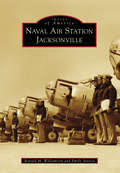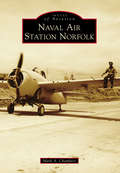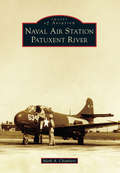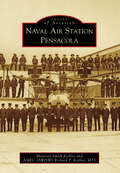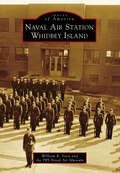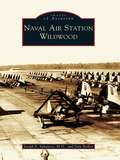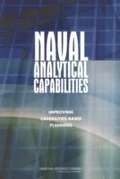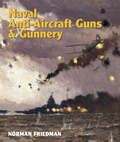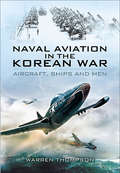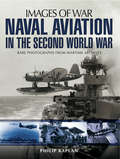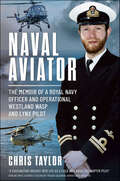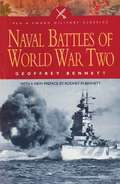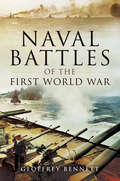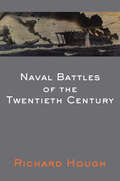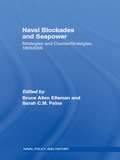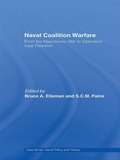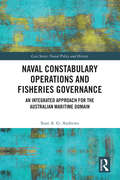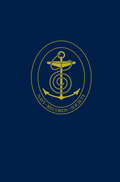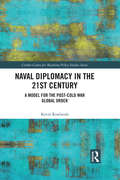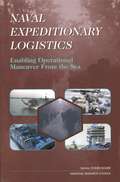- Table View
- List View
Naval Air Station Jacksonville (Images of America)
by Emily Savoca Ronald M. WilliamsonNaval Air Station Jacksonville was commissioned on October 15, 1940, and has trained tens of thousands of naval aviators throughout its long history. Located along the banks of the St. Johns River, the site and the weather conditions make the base a premier aviation facility. Initially conducting primary and sea-plane training, it expanded to training pilots in almost every type of aircraft the Navy has flown. The Navy's elite precision aviators, the Blue Angels, were formed at the base in 1946. Today, as a master antisubmarine base, it remains home to 15 aviation squadrons; some 115 tenant commands and almost 20,000 military, civilian, and contract employees work at the station daily.
Naval Air Station Norfolk (Images of Aviation)
by Mark A. ChambersThroughout the 20th century and the beginning of the 21st century, Naval Air Station Norfolk, Virginia, has played a significant role in the development of American naval aviation. The roles of fleet operational feasibility flight testing, flight testing of prototype aircraft, and tactical combat flight training at this naval air station have been crucial to this development. Technological advancements in naval airpower have significantly altered military doctrine and tactics, enabling the United States to gain strategic advantages over opposing forces in wars and military conflicts. Moreover, courage, innovative spirit, and ingenuity in conducting naval flight testing at Naval Air Station Norfolk have made and continue to make the advancement of American naval aviation possible. This remarkable military facility serves as a vital component of the world's largest naval base, Naval Station Norfolk.
Naval Air Station Patuxent River (Images of Aviation)
by Mark A. ChambersNaval Air Station Patuxent River (NAS Pax River) played a crucial role in forging America's naval air arm. This unique center proved to be vital for flight testing and evaluating naval aircraft and weapons systems destined for operational fleet service. NAS Pax River taught fleet pilots new tactics by conducting aircraft weapons tests, a tradition supplemented today by ground-based simulation. During and after World War II, it served as a primary center for flight testing and evaluating foreign aircraft. Some of the world's best test pilots and eventual astronauts came to NAS Pax River to hone their flight skills and to participate in the testing of naval aviation's premier aircraft. It is also home to the Naval Air Warfare Center Aircraft Division (NAWCAD) and the US Naval Test Pilot School, and it is the headquarters of the Naval Air Systems Command (NAVAIR).
Naval Air Station Pensacola (Images of Aviation)
by Amec Aw Sw Keillor Mts Maureen Smith KeillorA sign at the gate of Naval Air Station Pensacola (NASP) welcomes visitors to "The Cradle of Naval Aviation." And, indeed it is. The world's first naval aeronautical station, it came into being when the USS Mississippi (BB-23) arrived in Pensacola on January 20, 1914, with seven aircraft, nine officers, and 23 men. Today, NASP is a dynamic, active station, hosting several schools and several branches of the US military. It is also the home of the Navy's Flight Demonstration Squadron, the Blue Angels, as well as the renowned National Naval Aviation Museum (NNAM), which displays more than 100 years of naval aviation, from a replica Curtiss hydroplane to the F-14 Tomcat.
Naval Air Station Whidbey Island (Images of America)
by William R. Stein the PBY-Naval Air MuseumNaval Air Station (NAS) Whidbey Island in Washington State has a long and storied history that began in 1942 and continues to the present day. Tucked away on an island that is its namesake, NAS Whidbey was originally conceptualized as a small support base for an existing air station in nearby Seattle. That prewar plan was rapidly eclipsed by world events, and the proposed support base quickly evolved into an air station of its own right. Through historic photographs chosen from the archives of the US Navy, the PBY-Naval Air Museum, and the personnel of NAS Whidbey Island, both past and present, the story of the air station is told. These images will serve not only as a trip down memory lane for those stationed at Whidbey in days gone by, but will also illustrate to younger generations their connection to those who served in the not so distant past.
Naval Air Station Wildwood (Images of Aviation)
by Joan Berkey Joseph E. SalvatoreCommissioned on April 1, 1943, Naval Air Station Wildwood trained thousands of U.S. Navy airmen during World War II. Located in southern New Jersey on a peninsula bordered by the Atlantic Ocean and Delaware Bay, the air station was perfectly sited to provide them with the over-water practice they needed for fighting the Japanese fleet in the western Pacific theater. Some of the war's most lethal bombers-Helldivers and TBM-3E Avengers among them-were flown by members of naval fighter, dive-bombing, and torpedo-bombing squadrons based at the station from 1943 until 1945. At least 42 airmen lost their lives while training at the station, but their deaths brought about improvements in airplane design and tactics. Today only a handful of the station's 126 original buildings remain; the largest of these, Hangar No. 1, has been restored to its original appearance and houses Naval Air Station Wildwood Aviation Museum.
Naval Air: Celebrating a Century of Naval Flying
by Philip KaplanNaval aviation arrived early in the last century in the form of balloons and airships employed by the British Royal Navy for reconnaissance, and interest was stirring in naval circles in a greater aeronautical capacity for the service. Britain's tradition of projecting a global reach through her sea power would, in the view of many, be greatly enhanced by such a capability. Among the first advocates of military aircraft development was British naval minister, Winston Churchill.Over the course of the last century since this point of inception, huge leaps have been made in the design, development, and performance of naval aircraft. This comprehensive account, brought to us by eminent aviation historian Philip Kaplan, details the journey from origin through early development into wartime deployment. This is carried forward through post-war innovations and into modern conflicts such as the Falklands campaign. Attention is paid to the key landmarks of aviation history, such as Taranto, Pearl Harbour, The Doolittle Raid, the Battle of Midway and the Korean campaign. Reference is also paid throughout to the flying aces; the high points in the combat careers of the greatest naval and marine aviators of the past century. Kaplan weaves multiple threads in an effort to produce a comprehensive and detailed history. One of these is the part played by women in the history of flight, detailing a journey characterised by ever-closer involvement at the vanguard of aviation development, showing how societal changes have impacted upon this area in tune with others. Bringing the history up to date, there is a section dedicated to the Helicopter, its varying uses, current disposition and status of the various types in the U.S and British navies. Complemented by a collection of interesting photographs, this is sure to appeal to aviation enthusiasts as well as social historians of the past one hundred years; this isn't just a history of the various aircraft but of the people who got them off the ground and flew them into a new century.
Naval Analytical Capabilities: Improving Capabilities-based Planning
by National Research Council of the National AcademiesThe National Academies Press (NAP)--publisher for the National Academies--publishes more than 200 books a year offering the most authoritative views, definitive information, and groundbreaking recommendations on a wide range of topics in science, engineering, and health. Our books are unique in that they are authored by the nation's leading experts in every scientific field.
Naval Anti-Aircraft Guns and Gunnery
by Norman FriedmanThis book does for naval anti-aircraft defence what the author's Naval Firepower did for surface gunnery it makes a highly complex but historically crucial subject accessible to the layman. It chronicles the growing aerial threat from its inception in the First World War and the response of each of the major navies down to the end of the Second, highlighting in particular the widely underestimated danger from dive-bombing. Central to this discussion is an analysis of what effective AA fire-control required, and how well each navy's systems actually worked. It also takes in the weapons themselves, how they were placed on ships, and how this reflected the tactical concepts of naval AA defence. As would be expected from any Friedman book, it offers striking insights he argues, for example, that the Royal Navy, so often criticised for lack of 'air-mindedness', was actually the most alert to the threat, but that its systems were inadequate not because they were too primitive but because they tried to achieve too much.The book summarises the experience of WW2, particularly in theatres where the aerial danger was greatest, and a concluding chapter looks at post-1945 developments that drew on wartime lessons. All important guns, directors and electronics are represented in close-up photos and drawings, and lengthy appendices detail their technical data. It is, simply, another superb contribution to naval technical history by its leading exponent.
Naval Aviation in the Korean War: Aircraft, Ships and Men
by Warren ThompsonA history of the conflict in Korea with an emphasis on the crucial role of aviation. This in-depth history covers the role of US aircraft carriers and aircraft in stopping the North Korean initial push to the south; their role in the famous Inchon Landing and Pusan Perimeter break out; naval operations during the Marines&’ Chosin Reservoir march to the sea in December 1950; and the stabilization of the front lines after the Chinese entered the war during 1951. At this time, the emphasis for naval air operations was centered on interdiction behind the lines. The focus was on trying to stop road and rail traffic from resupplying the communist troops and allowing them to build up to a major offensive. Also described is the entry of the F2H Banshee into carrier operations, which gave the US four major types of aircraft with which to wage the war. During 1952, most carrier air groups spent their time off the coast of North Korea while hitting targets up along the Yalu River, putting them well within the range of MiG-15s. Navy F9F Panthers were used as top cover, while the Corsairs and Skyraiders went after major targets such as the dam complexes upriver and marshaling yards north of Pyongyang. During 1953, naval air operations were stepped up in an effort to get the communists back to the truce talks. The number of MiG-15s had grown to a figure many times that of the UN for overhead protection; the deep missions were more dangerous than ever; and the Chinese brought in state-of-the-art antiaircraft automatic weapons. This comprehensive book brings you into the action as the stakes get higher and higher before the conflict eventually draws to a close.
Naval Aviation in the Second World War: Rare Photographs From Wartime Archives (Images of War)
by Philip KaplanThe first aircraft carriers made their appearance in the early years of World War I. These first flattops were improvised affairs built on hulls that had been laid down with other purposes in mind, and it was not until the 1920s that the first purpose-built carriers were launched, but no-one was as yet clear about the role of the carriers and they were largely unloved by the 'battleship admirals' who still believed that their great dreadnoughts were the ultimate capital ships.World War II changed all that, At Taranto, Pearl Harbour, and in the North Atlantic, the carrier, the ugly duckling of the world's navies, proved itself to be the dreadnought nemesis. As the tide of war turned, the fast attack carriers of the U.S. Navy spearheaded the counter-attack in the Pacific while the makeshift escort carriers helped to seal the fate of the German U-boats in the Atlantic. The carrier, and naval aviation, thus emerged into the post-war world as the primary symbol and instrument of seapower; it would play a crucial role in the strategic encirclement of the Soviet Union and enabled western airpower to be rapidly and effectively deployed in areas of conflict as remote as Korea, Vietnam, the Falklands and the Gulf.Kaplan describes the adventure of the young American, British, and Japanese naval aviators in the Second World War. It is an account of their experiences based on archives, diaries, published and unpublished memoirs, and personal interviews with veteran naval airmen of WWII, providing a vivid and often hair-raising picture of the dangers they encountered in combat and of everyday life aboard an aircraft carrier. It considers some of the key aspects of the WWII naval aviator's combat career, such as why it was that only a tiny minority of these pilots those in whom the desire for aerial combat overrode everything accounted for such a large proportion of the victories.In the major carrier actions of that conflict, from the Royal Navy's attack on Taranto which crippled the Italian fleet in 1940, to the Japanese carrier-launched surprise attack on U.S. Navy battleships and facilities at Pearl Harbour in 1941, to the carrier battle of Midway in 1942, and the Great Marianas Turkey Shoot of 1944, through the Japanese Kamikaze campaign against the U.S. Carriers in the final stages of the Pacific war, this book takes the reader back to one of the most exciting and significant times in modern history.
Naval Aviator: The Memoir of a Royal Navy Officer and Operational Westland Wasp and Lynx Pilot
by Chris TaylorChris Taylor has had a very successful career as a Royal Navy officer, helicopter pilot, test pilot and instructor. His first book, Test Pilot, concentrates on anecdotes and incidents from the most recent phase of his career. His second book, Experimental Test Pilot, is an account of his ten years’ service as an experimental test pilot, from 1994 until 2004, at MoD Boscombe Down, the UK’s tri-Service home of military aircraft testing and evaluation. Written in the same humorous manner as his previous books, Naval Aviator explains why Chris wanted to become a pilot and how he achieved that through the Royal Navy and Fleet Air Arm. Following the, perhaps misleading, advice of his local careers office, Chris joined the Royal Navy on a University Cadetship which required him to serve initially as a watchkeeping and navigation officer before he could sub-specialise as a Westland Wasp and subsequently a Westland Lynx pilot. This book covers each appointment or ship that Chris served in, and provides a ‘no holds barred’ account of the many life-threatening and stressful situations he faced, not least working with, and for, some unhelpful if not outright unreasonable colleagues. The operating environment of a small ship’s flight is graphically described, including flying in extremely poor weather conditions and high sea states in order to ‘get the job done’. His ditching of a Wasp during training and then damaging his helicopter at sea is fully documented. In addition to numerous close calls as an aviator, Chris is unusual in being involved in four major collisions at sea. For one of these collisions he was the officer responsible for conning or ‘driving’ the ship and, despite his best efforts, his ship rammed a German Frigate in thick fog in the Baltic. Serving on a Hong Kong Patrol boat he had numerous encounters with armed Chinese patrol boats and soldiers; as a Fishery Protection Officer he was attacked with an acetylene blow torch and kidnapped by a French trawler; as a Wasp pilot he almost singlehandedly had to protect the Royal Yacht from the threat of Libyan gunboats; as a Lynx pilot he won the day in numerous major international exercises around the world and served for a month on detachment to a Dutch frigate. All of these accidents, incidents and adventures are fully described set alongside the challenges of trying to maintain a normal domestic life. Naval Aviator accurately captures the ups and downs of life as a Royal Navy Officer and Fleet Air Arm pilot of the Cold War and will be a good read for anyone interested in naval or aviation history. It is also an ideal book for aviators, aspiring aviators, service veterans and anyone who is considering such a career.
Naval Battles of World War Two (Pen & Sword Military Classics)
by Geoffrey BennettCaptain Bennett discusses the traumatic effects of the Washington and London Naval Treaties on the fleets of the principal powers between the wars, and their astonishing growth and technical progress between 1939 and 1945. He then deals with the war in the Atlantic and the Mediterranean. The Battle of the River Plate, the struggle for Narvik, the hunt for the Bismarck, the destruction of the Italian Fleet at Taranto and Matapan are all vividly described and authoritatively analysed.
Naval Battles of the First World War (Military Classics Ser.)
by Geoffrey BennettFrom a British Royal Navy officer, a detailed history of World War I&’s principal battles at sea. With the call to action stations in August 1914, the Royal Navy faced its greatest test since the time of Nelson . . . This classic history of the Great War at sea combines graphic and stirring accounts of all the principal naval engagements—battles overseas, in home waters and, for the first time, under the sea—with analysis of the strategy and tactics of both sides. Geoffrey Bennett brings these sea battles dramatically to life, and confirms the Allied navies&’ vital contribution to victory.Praise for Naval Battles of the First World War&“Strongly recommended.&” —RUSI Journal&“Excellent balanced accounts and judgements.&” —Richard Hough, historian and author&“Extensive photographs, include key aspects such as the German battle cruiser Blucher at the Dogger Bank battle, the destruction of the British battle cruiser Queen Mary, as well as the German dreadnaught Bayern sinking after being scuttled at Scapa Flow. A fascinating diagram shows Battleship Turrets, which provides insight into the process of action, such as the shell room, cordage charge, magazine, to the cordite hoist and gun.&” —Jon Sandison, historian
Naval Battles of the Second World War: Pacific and Far East
by Leo MarriottThe Second World War was a truly global conflict and maritime power played a major role in every theatre of operations. Land campaigns depended on supplies transported by sea, and victory or defeat depended on the outcome of naval battles. So Leo Marriott’s highly illustrated two-volume account of the struggle sets naval actions in the wider strategic context as well as giving graphic accounts of what happened in each engagement. This second volume concentrates on the epic struggle between the Americans and the Japanese in the vast expanses of the Pacific where for almost four years a great maritime campaign ebbed and flowed and some of the most famous naval battles of the conflict took place. The first part of the book covers the period from Pearl Harbor to Midway while the second covers the long and bloody campaign in the south-west Pacific where the US Navy honed its skills and turned a bloody defeat into a hard-won victory. The final section focuses on naval operations during the American advance across the central Pacific up to the Battle of Leyte Gulf – the greatest naval battle ever fought. Included are other actions involving the Royal Navy which, after early setbacks, would go on to play a major supporting role alongside the US Navy in the Pacific This concise but wide-ranging introduction to the naval war emphasizes the sheer scale of the conflict in every sea and shows the direct impact of each naval battle on the course of the war.
Naval Battles of the Twentieth Century
by Richard HoughThe major naval powers—Britain, America, Russia, and Japan—have all played a part in the theater of war at sea over the last one hundred years. Naval fighting has always been a rapidly developing affair, and in no century have changes been so swift and fundamental. In 1905, when this book begins, the first major engagement between ironclad fleets—the Battle of Tsu-Shima—took place in the Far East and decided the outcome of the Russo-Japanese war in Japan’s favor. What follows are the mighty sea battles of our century, graphically reconstructed for the reader. Victories, defeats, and mutinies at sea, from the battle with the Bismarck to the battles of Midway and Guadalcanal.
Naval Blockades and Seapower: Strategies and Counter-Strategies, 1805-2005 (Cass Series: Naval Policy and History)
by Bruce Allen Elleman Sarah C.M. PaineThis new collection of scholarly, readable, and up-to-date essays covers the most significant naval blockades of the nineteenth and twentieth centuries. Here the reader can find Napoleon’s Continental Blockade of England, the Anglo-American War of 1812, the Crimean War, the American Civil War, the first Sino-Japanese War 1894-95, the Spanish-American War, the First World War, the second Sino-Japanese War 1937-45, the Second World War in Europe and Asia, the Nationalist attempt to blockade the PRC, the Korean War, the Cuban Missile Crisis, the Vietnam War, the British blockade of Rhodesia, the Falklands War, the Persian Gulf interdiction program, the PRC "missile" blockade of Taiwan in 1996, and finally Australia's recent "reverse" blockade to keep illegal aliens out of the country. The authors of each chapter address the causes of the blockade in question, its long and short-term repercussions, and the course of the blockade itself. More generally, they address the state of the literature, taking advantage of new research and new methodologies to provide something of value to both the specialist and non-specialist reader. Taken as a whole, this volume presents fresh insights into issues such as what a blockade is, why countries might choose them, which navies can and cannot make use of them, what responses lead to satisfactory or unsatisfactory conclusions, and how far-reaching their consequences tend to be. This book will be of great interest to all students and scholars of strategic studies, military history and maritime studies in particular.
Naval Coalition Warfare: From the Napoleonic War to Operation Iraqi Freedom (Cass Series: Naval Policy And History Ser.)
by Bruce A. Elleman S.C.M. PaineThis is the first scholarly book examining naval coalition warfare over the past two centuries from a multi-national perspective. Containing case studies by some of the foremost naval historians from the US, Great Britain, and Australia, it also examines the impact of international law on coalitions. Together these collected essays comprise a compr
Naval Constabulary Operations and Fisheries Governance: An Integrated Approach for the Australian Maritime Domain (ISSN)
by Sean A. AndrewsThis book offers an analysis of naval constabulary operations, in particular Australian fisheries patrols, and challenges the widely accepted Anglo-American school of maritime thought.In the Indo-Pacific, fisheries and the activities of fishing boats are of increasing strategic importance in Australia’s region – Australia’s Four Oceans. Issues of overfishing, population growth and climate change are placing growing pressure on fish as a resource, and in doing so are making fisheries more significant, and significant on a strategic as opposed to simply an economic or environmental level. When, combined with the growing use of fishing vessels as para-naval forces, it is clear that the activities of fishing vessels, whether fishing or not fishing, are matters of considerable strategic relevance. This book illuminates contemporary seapower challenges, explains and defines maritime security and examines and refines existing theory to advance a set of new or refined concepts to help frame the on-water activities of constabulary operations -- reducing the possibility of on-water miscalculation between states.This book will be of much interest to students and scholars of naval studies and sea power, maritime strategy, maritime security and International Relations.
Naval Courts Martial, 1793-1815 (Navy Records Society Publications #155)
by John D. ByrnThis collection of naval court martial transcripts and related documents from the time of the French Revolutionary and Napoleonic Wars contributes not only to our understanding of military jurisprudence in the late eighteenth and early nineteenth centuries but also to our knowledge of Georgian and Regency criminal law in general. Each chapter presents transcripts relating to different groups of offences. Chapter one deals with procedural matters; Chapter Two covers trails arising from transgressions of the laws of Georgian and Regency society like drunkenness, theft, violence and homosexuality. Chapter Three is devoted to proceedings against types of naval offence, such a mutiny, insolence, desertion or loss of ship. Chapter Four treats of cases involving adjudications for multiple infractions. These transcripts are presented in their entirety and offer a unique window to the social conditions and behaviour aboard the King's ships at the time.
Naval Diplomacy in 21st Century: A Model for the Post-Cold War Global Order (Corbett Centre for Maritime Policy Studies Series)
by Kevin RowlandsThis book offers a detailed investigation of naval diplomacy, past and present, and challenges the widely accepted Anglo-American school of sea power thought. Despite the acknowledgement of the importance of the threat or use of force in the pursuit of policy since the dawn of strategic thought, the utility of seapower in operations other than war is poorly understood and articulated. Theorists have invariably viewed seapower in peacetime through the lens of hard power effects such as coercion and deterrence. Commentaries on engagement, interoperability and the forging of friendships are largely conspicuous by their absence. This book considers how all these strands of international politics can be better understood for use in the 21st century. The book explains and defines naval diplomacy, with existing theoretical frameworks being critically analysed. It reviews over 500 incidents from the post-Cold War era, drawing on this empirical evidence to determine that naval diplomacy remains a potent means of 21st century statecraft. It finds that existing understanding of naval diplomacy is insufficient and offers an alternative model, drawing on basic communication and stakeholder theories. The implications of the book relate directly to national security: naval deployments could be more effectively targeted; foreign activity at sea could be better understood and, if necessary, countered; finally, the ability of non-state actors to support national interests from the sea could, potentially, be better harnessed. This book will be of much interest to students of naval power, maritime security, strategic studies and International Relations.
Naval Engineering in the 21st Century:The Science and Technology Foundation for Future Naval Fleets -- Special Report 306
by The National Academy of SciencesNaval Engineering in the 21st Century: The Science and Technology Foundation for Future Naval Fleets examines the state of basic and applied research in the scientific fields that support naval engineering and explores whether Office of Naval Research (ONR) activities, under its National Naval Responsibility for Naval Engineering (NNR-NE) initiative, have been effective in sustaining these fields.
Naval Expeditionary Logistics: Enabling Operational Maneuver From the Sea
by National Research CouncilInformation on Naval Expeditionary Logistics
Naval Eyewitnesses: The Experience of War at Sea, 1939–1945
by James Goulty"Goulty tells the story from the perspective of the ordinary sailor or officer who was there."—The Northern MarinerAlthough many books have been written about naval actions during the Second World War – histories and memoirs in particular – few books have attempted to encompass the extraordinary variety of the experience of the war at sea. That is why James Goulty’s vivid survey is of such value. Sailors in the Royal Navy and the Merchant Navy experienced a war fought on a massive scale, on every ocean of the world, in a diverse range of vessels, from battleships, aircraft carriers and submarines to merchant ships and fishing boats. Their recollections are as varied as the ships they served in, and they take the reader through the entire maritime war, as it was perceived at the time by those who had direct, personal knowledge of it. Throughout the book the emphasis is on the experience of individuals – their recruitment and training, their expectations and the reality they encountered on active service in many different offensive and defensive roles including convoy duty and coastal de-fence, amphibious operations, hunting U-boats and surface raiders, mine sweeping and manning landing and rescue craft. A particularly graphic section describes, in the words of the sailors themselves, what action against the enemy felt like and the impact of casualties – seamen who were wounded or killed on board or were lost when their ships sank. A fascinating inside view of the maritime warfare emerges which may be less heroic than the image created by some post-war accounts, but it gives readers today a much more realistic impression of the whole gamut of wartime life at sea.
Naval Firepower: Battleship Guns and Gunnery in the Dreadnought Era
by Norman FriedmanAn in-depth history of naval battleship firepower from before World War I to the end of World War II, by America&’s leading naval analyst. For more than half a century, the big gun was the arbiter of naval power, but it was useless if it could not hit the target fast and hard enough to prevent the enemy doing the same. Because the naval gun platform was itself in motion, finding a &“firing solution&” was a significant problem exacerbated when gun sizes increased, fighting ranges lengthened, and seemingly minor issues like wind velocity had to be considered. To speed up the process and eliminate human error, navies sought a reliable mechanical calculation. This heavily illustrated book outlines for the first time in layman&’s terms the complex subject of fire-control, as it dominated battleship and cruiser design from before World War I to the end of the dreadnought era. Covering the directors, range-finders, and electro-mechanical computers invented to solve the problems, author Norman Friedman explains not only how the technology shaped (and was shaped by) the tactics involved, but also analyzes their effectiveness in battle. His examination of the controversy surrounding Jutland and the relative merits of competing fire-control systems draws surprising conclusions. He also reassesses many other major gun actions, such as the battles between the Royal Navy and the Bismarck, and the U.S. Navy actions in the Solomons and at Surigao Strait. All major navies are covered, and the story concludes at the end of World War II with the impact of radar.
